
Sutton Bonington is a village and civil parish lying along the valley of the River Soar in the Borough of Rushcliffe, south-west Nottinghamshire, England. The University of Nottingham has a 420 hectares (4.2 km2) site just to the north of the village: Sutton Bonington Campus.

Bingham is a market town and civil parish in the Rushcliffe borough of Nottinghamshire, England, 9 miles (14 km) east of Nottingham, 12 miles south-west of Newark-on-Trent and 15 miles west of Grantham. The town had a population of 9,131 at the 2011 census, with the population now sitting at 10,080 from the results of the 2021 census data.

Aslockton is an English village and civil parish 12 miles (19 km) east of Nottingham and 2 miles (3.2 km) east of Bingham, on the north bank of the River Smite opposite Whatton-in-the-Vale. The parish is also adjacent to Scarrington, Thoroton and Orston and within the Rushcliffe borough of Nottinghamshire. The population was recorded as 974 in the 2011 census, doubling to 1,937 at the 2021 census.

Alverton is an English hamlet and civil parish in the Newark and Sherwood district of Nottinghamshire. It is joined by neighbouring Kilvington to form an area for a parish meeting. It contains 22 houses surrounded by farmland, and reported 61 residents in the 2021 census. The River Devon and its tributary, the Winter Beck, run along its eastern border.
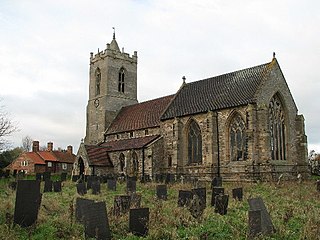
Car Colston is an English village and civil parish in the Rushcliffe borough of Nottinghamshire. The population of the civil parish at the time of the 2011 census was 185, falling to 171 at the 2021 census.

Bingham was a wapentake of the historic county of Nottinghamshire, England. It was in the south-east of the county, to the south of the River Trent.
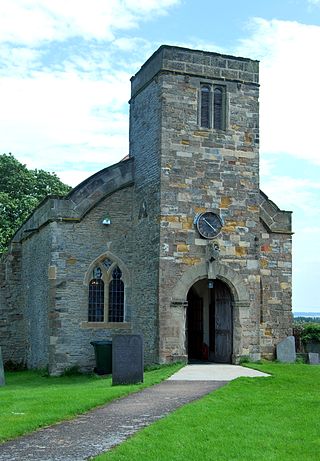
Owthorpe is a small English village and civil parish in the Wolds of the East Midland county of Nottinghamshire. The population of about 90 was included in the civil parish of Cotgrave in the 2011 Census.

Orston is an English village and civil parish in the Rushcliffe borough of Nottinghamshire, 15 miles east of Nottingham. It borders the parishes of Scarrington, Thoroton, Flawborough, Bottesford and Elton on the Hill. The population at the 2011 census was 454.
Whatton-in-the-Vale is an English village in the Nottinghamshire borough of Rushcliffe. It lies in the Vale of Belvoir, with the River Smite to the west and the River Whipling to the east, mainly north of the trunk A52 road, 12 miles (19 km) east of Nottingham. It had a population of 843 at the 2011 census.
Barnstone is an English village in the Rushcliffe borough of Nottinghamshire, forming part of Langar cum Barnstone parish. It lies on the border with Leicestershire. The nearest retail stores, schools and railway station are in Bingham. The spelling in the 19th century was usually "Barnston". The parish church of St Mary's belongs to the Wiverton group, but is not currently in use.

Thoroton is a small English parish in the borough of Rushcliffe, Nottinghamshire, with a population of 112. The village has conservation area status. Its Anglican parish church is a Grade I listed building.

Langar is an English village in the Vale of Belvoir, about four miles south of Bingham, in the Rushcliffe borough of Nottinghamshire. The civil parish of Langar cum Barnstone had a population of 980 at the 2011 Census. This was estimated at 1010 in 2019.
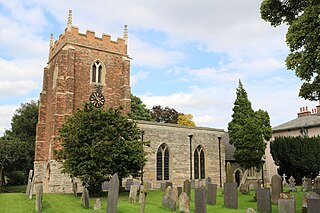
Hawksworth is an English conservation village and civil parish in the Rushcliffe borough of Nottinghamshire. It lies 10 miles (16 km) south of Newark-on-Trent, adjacent to the villages of Flintham, Sibthorpe, Thoroton, Scarrington and Screveton.

Tithby is an English village in the Rushcliffe borough of Nottinghamshire, about 2.6 miles (4.2 km) south of the market town of Bingham. The civil parishes of Tithby and Wiverton Hall have a joint annual parish meeting and a combined population of about 95.
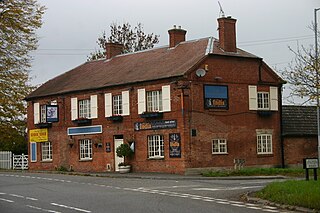
Elton on the Hill is a hamlet and civil parish in Nottinghamshire, England and within the Vale of Belvoir. A population of 114 was reported at the 2021 census.

St Michael and All Angels' Church, Elton on the Hill is a parish church in the Church of England in Elton on the Hill, Nottinghamshire. It is Grade II listed by the Department for Digital, Culture, Media and Sport as a building of special architectural interest.

Sutton-cum-Granby is a hamlet in the Borough of Rushcliffe in Nottinghamshire, England. It lies in the Vale of Belvoir.
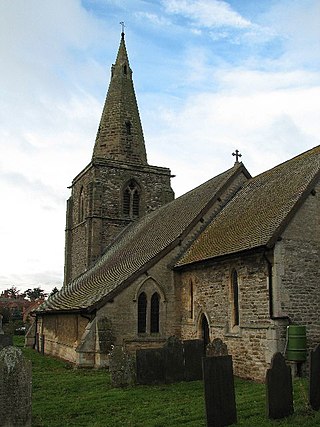
Scarrington is an English civil parish and village in the Rushcliffe borough of Nottinghamshire, adjacent to Bingham, Car Colston, Hawksworth, Orston and Aslockton. Its 973 acres had a population in 2011 of 183. It lies at Ordnance Survey grid reference SK7341 in the undulating farmland of the Vale of Belvoir, some 2 miles (3.2 km) from the town of Bingham and from a stretch of the Roman Fosse Way (A46) between Newark and Leicester. It is skirted by the A52 road between Nottingham and Grantham.


















